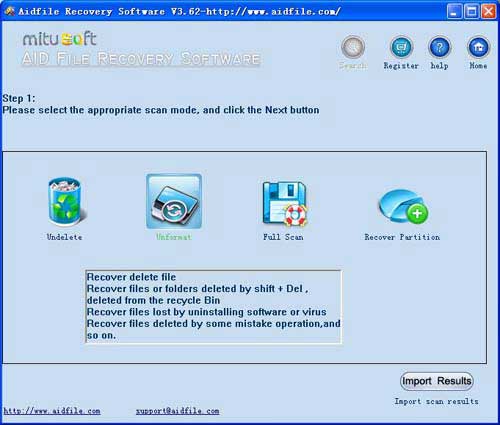Formatted hard drive recovery software in Windows 7/10/XP to recover files from formatted hard drive, free download and trial.
Use "Undelete" mode to recover deleted files from formatted hard drive after Virus attack,Recycle bin clear,disk cleanup,Press shift del by mistake,permanently empty recycle bin,shift delete ,accidentally deleted by a mistake..
Use "Unformat" mode to retrieve data from formatted hard drive after quick format,full format,accidentally formatted,reformatting,High-level formatting,Low-level formatting quickly.
Use "Recover partition" mode to rescue files if partitions changed or damaged or deleted.
Use "Full Scan" mode to rescue lost files if partitions show as "raw" or recover deleted files which can not be found with "undelete" and "unformat" and "recover partition",recover files from raw partition,recover files of partitons which are not NTFS,nor exfat,nor fat32.
As a user,whatever we tell you,whatever you want,just try it. If Aidfile can help you,we congratulate ,if not,just contact us.
At the same time, you can also recover files after other storage devices format, such as formatted SD card, digital camera , and so on.
When you format a hard disk drive, the operating system erases all bookkeeping information on the hard drive. Note that reformatting a disk does not erase the data on the disk, only the data on the address tables. Do not be worry, if you accidentally reformat a hard drive that has useful data. As a general rule, formatting a disk leaves most if not all existing data on the disk medium; some or most of which might be recoverable with special tools.[4] Special tools can remove user data by a single overwrite of all files and free space.The process of initializing these logical blocks on the physical disk platters is called low-level formatting, which is usually performed at the factory and is not normally changed in the field. As a next step in preparing an HDD for use, high-level formatting writes partition and file system structures into selected logical blocks to make the remaining logical blocks available to the host's operating system and its applications.The file system uses some of the disk space to structure the HDD and organize files, recording their file names and the sequence of disk areas that represent the file. Examples of data structures stored on disk to retrieve files include the File Allocation Table (FAT) in the DOS file system and inodes in many UNIX file systems, as well as other operating system data structures (also known as metadata). As a consequence, not all the space on an HDD is available for user files, but this system overhead is usually negligible.
Aidfile have a free edition for you recovering 1G files with no pay.Just free download and try it.
Aidfile Keyfeature
support Windows 11 & Windows 10, Windows XP, Windows 7, Windows 8,Windows 8.1, Windows Vista, Windows 2003, 2008, 2012.
Support 32 bits, 64 bits.
Support WD, Samsung, Sandisk, Toshiba, Seagate, HP, Lenovo,Maxtor,etc.
Support MS Office document (Word, Excel, PowerPoint, Outlook) types (doc, docx, ppt, pptx, xls, xlsx, pst, etc.),photos (JPG, PNG, ICON, TIF, BMP, RAF, CR2, etc.), videos and audios (MPG, MP4, MP3, MTS, M2TS, 3GP, AVI, MOV, RM, RMVB, etc.), compressed files (rar, zip, etc.), PE files (exe, dll, lib, etc.) and so on.





